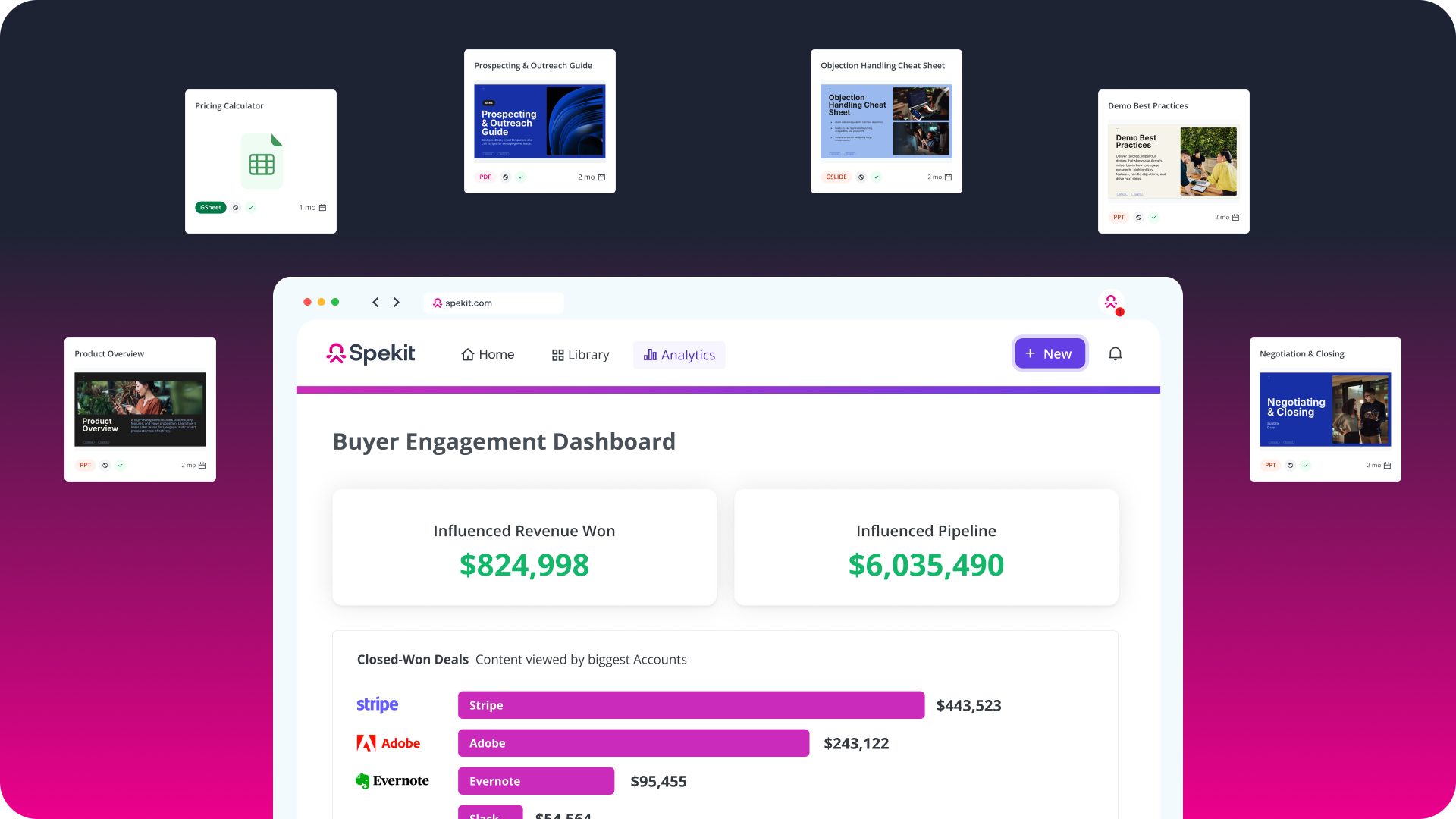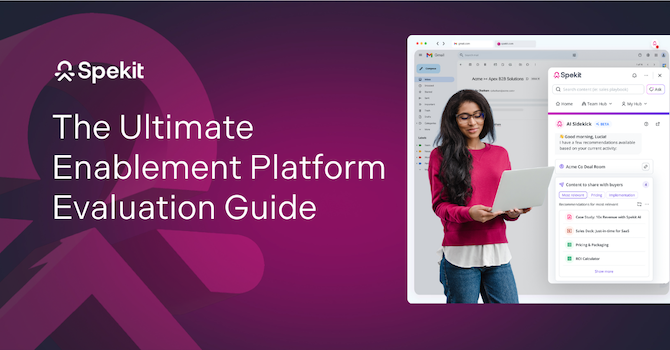Sales battle cards: your strategic cheat sheet — now supercharged with AI.
To deliver an effective sales pitch, reps need ready-to-use intel on competitors, pricing, outcomes, and proof. Modern teams don’t just store that intel, they generate, personalize, and deliver it in-flow with AI.
With tools like şÚÁĎłÔąĎÍř AI, you can auto-draft battle card content from source docs, answer rep questions in real time, and proactively surface the one best talking point inside Salesforce, Gmail/Outlook, or a call tool.
Research shows  provide sales battle cards and 71% of teams using them see higher win rates. This guide covers why battle cards matter, the common types, and how to build AI-powered, just-in-time versions that actually move deals.
What is a Battle Card in Sales?
Battle cards are similar to flashcards–but instead of words and definitions, they include high-value information and talking points that help sales reps close deals. Depending on the type of sales battle card, they’ll provide an overview of your business’s products, features, services, and pricing compared to your competitors.
Typically, battle cards are one-pagers, and the best battle cards focus on value proposition, provide facts and statistics to support claims, and include likely counter-questions from prospects.Ěý
Teams increasingly use AI to summarize long documents into one-page cards, propose “why we win” language from win-loss notes, and keep entries current with quiet prompts when something looks stale.

Why Do Sales Teams Need Battle Cards?
Battle cards are a concise, strategic sales enablement tool that equips sales teams with key information and messaging to effectively navigate and win competitive sales situations.
Make an Effective Pitch
Sales reps report that learning the product they’re selling can be incredibly challenging. Imagine reps having to pitch to prospects, and all the information they need is scattered across websites, folders, or content repositories. That won’t make for an effective pitch.Ěý
Sales battle cards are condensed cheat sheets that reps can easily access and reference during calls. With all the information they need at their fingertips, reps can craft personalized pitches based on customer persona, highlight brand offerings, and respond quickly to any counter questions–ultimately leading to higher sales productivity.
AI can pull the top three points and citations from a card based on the live conversation or email thread, so reps don’t scroll for answers.
Stay Ahead of Competition
monitor their competitors. Sales battle cards are the easiest way to keep reps updated on new features and offerings rolled out by the business and competitors–and how your product stacks up.Ěý
For example, let’s say your competitor newly launched a flexible integration feature in their product, and your product already has this capability (but much better!). If you include this point in a battle card, sales reps can pull this out to show how ahead you are of the competition–and why your service or product is the best choice.Ěý
AI can monitor public changes (pricing, packaging, messaging) and suggests small edits to the relevant sections for review to reduce manual hunting.
Prepare for Customer Challenges
Battle cards commonly summarize customer challenges and how a business’s products, services, and features can address customer-specific pain points. This gives sales reps clarity on prospect personas and how best to tailor pitches to address their unique needs. more than 35% of customers will use a product if given personalized offers, regardless of how much they have to pay.Ěý
Using AI, you can detect common objection themes in transcripts and maps them to the right rebuttal plus evidence.
Create Situational Pitches
Navigating conversations with prospects can be challenging when sales reps are unprepared for counterarguments prospects might present. Sales battle cards help reps handle situational pitches by outlining possible situations and providing talking points for sales reps, increasing customer growth rates and sales pipelines.Ěý
For example, when a prospect is comparing your product features to a competitor’s features, a good battle card outlining feature-by-feature comparisons will enable reps to communicate your product’s strengths and unique features.Ěý
Types of Battle Cards
Here are some of the most common types of battle cards:
Competitor Battle Cards
In recent years, have become more competitive, emphasizing the need to monitor competitors. Competitor battle cards detail your competitor’s profile. They contain information such as their customer profile, market value, pricing, product features, and services. For example, Salesforce might prepare battle cards on top competitors like HubSpot, Zoho, and Microsoft Dynamics.Ěý

These battle card examples also work well with objection-handling battle cards since they typically hint at what to say when a prospect raises concerns.Ěý
Objection Handling Battle Cards
These are objection-response guides designed to enable sales teams to effectively handle objections, counterarguments, concerns, or hesitation on the part of the prospect. They provide standard responses to frequently asked questions and common objections from potential customers.Ěý
Objection-handling battle cards are great because they ensure sales reps aren’t thrown off their game if a prospect counters their pitch.Ěý
Product & Feature-focused Battle Cards
Product battle cards serve as training material for sales teams. These cards may be designed for one product or feature or a combination of products and features with specific use cases.Ěý
They provide an overview of everything reps need to know about the product or specific feature that they’re pitching. Information contained in these cards includes industries where the market for the product exists, potential customer pain points, the product’s value, and any unique features that would benefit prospects.Ěý
Value Proposition-based Battle Cards
What is the value of your product to prospects? Efficiency? Cost savings? Seamless integrations?Â
Value-proposition battle cards use value selling to show prospects why they should choose your product. They should showcase how a solution will solve the prospect’s problems and provide significant benefits. This should include any factors that show what positive outcomes customers can expect from the solution.
Prospect-Specific Battle Cards
Prospect-specific battle cards are personalized for particular prospects. It provides elaborate information on a potential customer based on their preferences, pain points, and unique characteristics.Ěý
The difference between this battle card and others is the level of personalization. A prospect-specific battle card shows:Â
- Overview: Background information on the prospect, such as company name, industry, location, and size.Ěý
- Challenges: Specific issues the prospect is facing and how your product can helpÂ
- Competitor Landscape: Insights on what your competitors offer the client and what differentiates your products from theirs.
- Success Stories and Case Studies: Relevant testimonials prove how similar clients have benefited from using your product.Ěý
- Objection responses: Answers to possible objections by the prospect.Ěý
Industry-specific Battle Cards
Certain industries have distinct challenges and opportunities. For example, in terms of software integrations, prospects in the financial industry would be concerned with high-security fintech integrations, while prospects in the medical industry would have challenges around integrating new tech such as electronic health records.Ěý
Industry-specific battle cards provide sales reps with frequently asked industry-specific questions. It also includes industry updates such as government regulations, new market entrants, the latest trends, etc.
Upsell Battle card
When sales reps are preparing to upsell to existing customers, upsell battle cards guide them on what to offer customers. These battle cards feature information on customer behavior— for example, if a customer sends many emails regularly.Ěý
Then, an upsell battle card will provide the sales rep with one or more compelling offers to convince the customer to upgrade.Ěý
How to Create & Use Competitive Battle Cards for Sales
Let’s take a look at some of the best practices for creating useful sales battle cards:Â
1. Create Battle Card Templates
Standard templates make it easier to train your sales team to adopt battle cards and retain knowledge about your products. How? Templates mean that information on battle cards is always arranged in a particular order so that sales reps can find the right information quickly.Ěý
For example, if all your battle card templates put product features at the top left corner and pricing in the top right, reps can pick that out easily, even when working with new battle cards.Ěý
Keep a consistent layout (Why we win, Risks, Proof, Talk tracks). şÚÁĎłÔąĎÍř AI can prefill draft text from decks, briefs, and notes; reviewers approve before publish.
If you’re looking simple templates to help you design useful sales templates, try şÚÁĎłÔąĎÍř. Using şÚÁĎłÔąĎÍř's expert-written, free battle card templates, you can create and share battle cards to start empowering your team in minutes.
The best part? They can be integrated directly into the flow of work. Prospecting happens in real-time, so your battle cards should also be available in real-time.

2. Know Where You ExcelÂ
lack confidence in buyers’ understanding of what differentiates their product. That’s where battle cards come in. Most value proposition and product battle cards have a “why we win” section. This section provides the strengths of your company/product against competitors' weaknesses to illustrate how your business excels over others.Ěý
To create a “why we win” section, you first need to know the value of business. You can get this information by researching competitors and comparing their products and features to yours. Support this using case studies, feedback, and testimonials from clients.Ěý
3. (Lots of) Research!
Creating battle cards requires hours, if not days, of research.Ěý If you’re put off by how much effort is required, just remember your competitors are .Ěý You must collect information on your competitors, products, and customers. These typically go into building your product overview, customer persona, value proposition, commonly asked questions and objections, competitor profiles, unique features and offerings, etc.Ěý
Because you’re designing these battle cards for your sales teams, they should be your first point of research, especially when gathering customer details.Ěý
4. Customize Battle CardsÂ
Customized battle cards enable sales reps to present better pitches. Battle cards can be customized for a particular prospect, competitor, or product to help reps respond quicker to prospect objections and questions.Ěý
Create customized battle cards with contextual information using Speks. şÚÁĎłÔąĎÍř’s Speks feature will enable you to deliver personalized bite-sized battle cards to your sales team wherever needed so that reps spend less time searching for information they need about your product.Ěý
This feature is great for onboarding new sales reps as it offers a knowledge base where all battle cards can be stored and a customized learning path that allows you to organize battle cards in whichever sequence you want them to be read.Ěý
Create customized battle cards with şÚÁĎłÔąĎÍř today
5. Access Battle Cards
If your sales team has to dig through mountains of folders to find battle cards, it would disrupt their workflow and discourage them from integrating battle cards into their sales methods.Ěý
Keep battle cards easily accessible by storing them on a platform that the team consistently uses. şÚÁĎłÔąĎÍř’s AI Sidekick feature allows you to embed battle cards into whichever platform the sales team works on, streamlining the process of arming your team with battle cards.Ěý
Regardless of the platform, reps can quickly access the battle card information they need.Ěý şÚÁĎłÔąĎÍř is committed to delivering the required information to wherever your team needs it. Why? The easier it is for reps to access battle cards, the more likely they will use it.ĚýÂ
Ensure reps use battle cards today.
6. Update Battle Cards RegularlyÂ
Over time, your company details, products, features, and value proposition will evolve. Battle cards should be updated to reflect those changes so sales teams aren’t making pitches using outdated information. They should also be updated to reflect industry and competitor changes.Ěý
This means you’ll need to use a platform that allows you to update or edit the information on battle cards immediately after changes occur. şÚÁĎłÔąĎÍř’s Speks makes updating battle cards seamless since battle cards can be updated from wherever you are.Ěý
It is also important to always inform the sales teams when battle cards are updated. Using şÚÁĎłÔąĎÍř’s Spotlight feature, you can quickly communicate updates without disrupting productivity.Ěý
General Sales Battle Card Template: What to Include
Here’s how to create a sales battle card template:Â
Company information
Clients expect sales reps. Equip your sales team with everything they need to know about the company: industry, history, geographical locations, and management.Ěý
Unique Selling Points & Features
Your battle card should have information on all products, features, and services your business offers. As your product grows or as you add more features, the battle card should be updated so that reps are always aware of new information.ĚýÂ
But, you also want to see how your product stacks up against similar products–and why a prospect should choose yours. Bonus points if the battle cards provide a side-by-side comparison to competitors.Ěý
Benefits & ValuesÂ
The importance of including the benefits and value of your product cannot be overemphasized, as it provides sales reps with talking points backed up by facts. The benefits could be qualitative or quantitative.Ěý
For example, if your email automation feature helps reduce customers' time sending emails by 40%, or your AI training tool supports personalized sales coaching, it should be noted in your battle card.Ěý
Use CasesÂ
If sales reps can’t give instances of your product use cases, they’re not likely to convince a prospect to use it. Your general sales battle card must include what challenges your product solves, how it can be used, and how you’re solving similar challenges for similar clients.Ěý
Customer Success Stories
You might have all the benefits and value of your product down to the T, but real-life customer success stories are sweetening the tea for prospects. They are proof that your product solves customer challenges.Ěý
For more convincing pitches, collect and include testimonials from current clients in your battle cards.Ěý
Optimize Your Sales Battle Cards for Success
Sales battle cards are a dynamic sales enablement tool that addresses different sales teams' needs. Your sales team should always be armed with battle cards that provide information on your company and your competitors so that sales reps can converse with clients.Ěý
However, sales reps are only as effective as the battle cards you design for them. And that’s where şÚÁĎłÔąĎÍř comes in. With şÚÁĎłÔąĎÍř’s sales and revenue enablement features, the platform streamlines the creation and updating of battle cards, offering customization and storage features that enable your sales team to access battle cards on the go.Ěý
Pair conversation insights with lightweight, governed cards. Let şÚÁĎłÔąĎÍř AI do the first draft, propose updates, and surface the right line at the right moment. Keep humans in the loop for approval and nuance.
The result is less searching, more consistent messaging, and a clear path from content to outcomes without adding more tools for reps to manage.







